check engine CHEVROLET LOW CAB FORWARD 2018 Owners Manual
[x] Cancel search | Manufacturer: CHEVROLET, Model Year: 2018, Model line: LOW CAB FORWARD, Model: CHEVROLET LOW CAB FORWARD 2018Pages: 358, PDF Size: 6.32 MB
Page 245 of 358
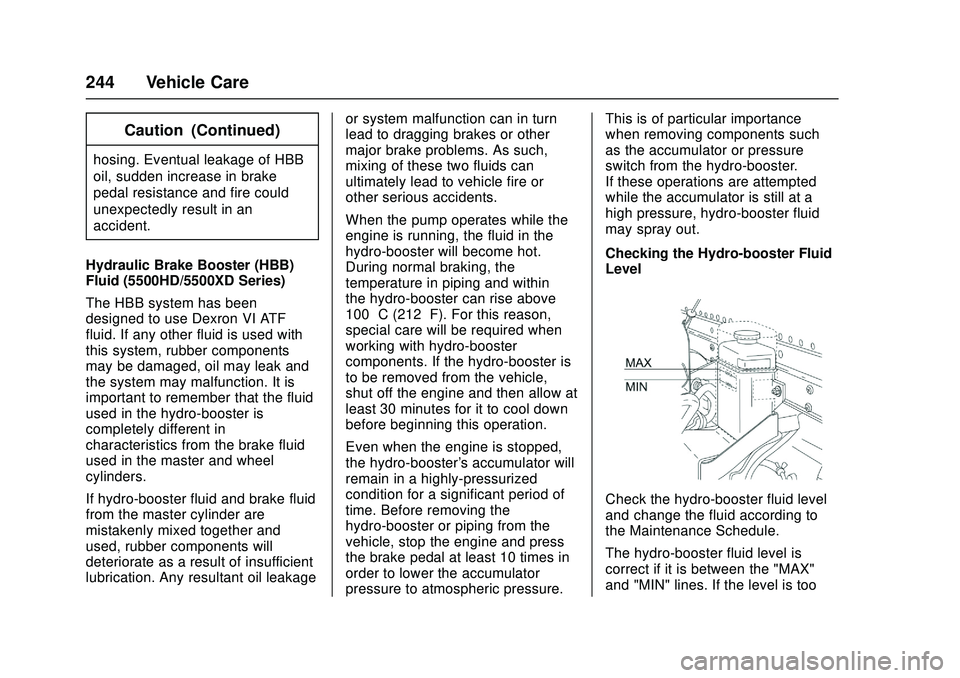
Chevrolet Low Cab Forward Owner Manual (GMNA-Localizing-U.S.-
11254764) - 2018 - crc - 12/5/16
244 Vehicle Care
Caution (Continued)
hosing. Eventual leakage of HBB
oil, sudden increase in brake
pedal resistance and fire could
unexpectedly result in an
accident.
Hydraulic Brake Booster (HBB)
Fluid (5500HD/5500XD Series)
The HBB system has been
designed to use Dexron VI ATF
fluid. If any other fluid is used with
this system, rubber components
may be damaged, oil may leak and
the system may malfunction. It is
important to remember that the fluid
used in the hydro-booster is
completely different in
characteristics from the brake fluid
used in the master and wheel
cylinders.
If hydro-booster fluid and brake fluid
from the master cylinder are
mistakenly mixed together and
used, rubber components will
deteriorate as a result of insufficient
lubrication. Any resultant oil leakage or system malfunction can in turn
lead to dragging brakes or other
major brake problems. As such,
mixing of these two fluids can
ultimately lead to vehicle fire or
other serious accidents.
When the pump operates while the
engine is running, the fluid in the
hydro-booster will become hot.
During normal braking, the
temperature in piping and within
the hydro-booster can rise above
100 °C (212 °F). For this reason,
special care will be required when
working with hydro-booster
components. If the hydro-booster is
to be removed from the vehicle,
shut off the engine and then allow at
least 30 minutes for it to cool down
before beginning this operation.
Even when the engine is stopped,
the hydro-booster's accumulator will
remain in a highly-pressurized
condition for a significant period of
time. Before removing the
hydro-booster or piping from the
vehicle, stop the engine and press
the brake pedal at least 10 times in
order to lower the accumulator
pressure to atmospheric pressure.This is of particular importance
when removing components such
as the accumulator or pressure
switch from the hydro-booster.
If these operations are attempted
while the accumulator is still at a
high pressure, hydro-booster fluid
may spray out.
Checking the Hydro-booster Fluid
Level
Check the hydro-booster fluid level
and change the fluid according to
the Maintenance Schedule.
The hydro-booster fluid level is
correct if it is between the "MAX"
and "MIN" lines. If the level is too
Page 246 of 358

Chevrolet Low Cab Forward Owner Manual (GMNA-Localizing-U.S.-
11254764) - 2018 - crc - 12/5/16
Vehicle Care 245
low, add fluid up to the "MAX" line.
Be sure to use Dexron VI ATF fluid
when adding fluid. The brake
booster reservoir is located behind
the cab on the left side.
Brake Pedal
Stroke
Shut off the engine and press the
brake pedal about 10 times strongly,
then check the brake pedal for free
play by lightly pushing it by hand
until you feel resistance.Free play (measured at the tip of
pedal)
5 - 10 mm (0.20 - 0.39 in) (4500HD/4500XD)
24 - 29 mm (0.95 - 1.14 in) (5500HD/5500XD)1. Clearance from the floor.
2. Brake pedal bracket.
Next, start the engine, and wait at
least 1 minute. Then press the
brake pedal and measure the
clearance (1) of the pedal from the floor (that is, the distance between
the brake pedal bracket (2) and the
brake pedal arm).
Clearance between the brake
pedal and the brake pedal bracket with a pressure of 490 N (110 lbs)
applied to the brake pedal
35 mm (1.38 in) or more (4500HD/ 4500XD)
Clearance between the brake
pedal and the brake pedal bracket with a pressure of 294 N (66 lbs) applied to the brake pedal
35 mm (1.38 in) or more (4500HD/ 4500XD/5500HD/5500XD)
If, after continued pressing of the
brake pedal, the clearance slowly
decreases or the pedal action feels
spongy, air may be trapped in the
brake hydraulic circuit. Have your
vehicle inspected at the nearest
dealer as soon as possible.
Page 249 of 358

Chevrolet Low Cab Forward Owner Manual (GMNA-Localizing-U.S.-
11254764) - 2018 - crc - 12/5/16
248 Vehicle Care
Danger (Continued)
battery. Personal injury
(particularly to eyes) or property
damage may result from battery
explosion, battery fluid or
electrical (short circuit) burns. You
and others could be seriously
injured or killed.
If the negative cable is disconnected
from the negative terminal on the
battery within 3 minutes after turning
the engine control switch to the
"LOCK" position, the engine control
module may malfunction.
Checking the Battery
Your new vehicle is equipped with
DELKOR batteries. They need no
periodic electrolyte level
maintenance. Its top is permanently
sealed (except for two small vent
holes) and has no filler caps. You
will never have to add water.
Remember to check and recharge
the battery as necessary, as well as
keep connection clean. The hydrometer (green-eye test
indicator) in the top of each battery
(if equipped) provides information
for testing purposes only.
If the vehicle is not going to be
driven for 30 days or longer,
disconnect the ground cable from
the negative (–) terminal of the
batteries to prevent discharge.
For full power needs at replacement
time, a battery with the same
specifications, as shown on the
original battery's label, is
recommended.
{Warning
Battery posts, terminals and
related accessories contain lead
and lead compounds, chemicals
known to the State of California to
cause cancer and reproductive
harm. Wash hands after handling.
You and others could be seriously
injured.
Fuel Filter
Change the fuel filter in accordance
with the Maintenance Schedule or
when the fuel filter indicator light
(amber) comes on.
Drain the water when the water
separator (fuel filter) warning light
comes on. (Drain the water from the
chassis-side fuel filter and
engine-side fuel filter.)
Failure to replace the fuel filter when
needed may lead to fuel system
damage. Your authorized dealer can
inspect your fuel filter and replace
your fuel filter, if needed.
Page 252 of 358
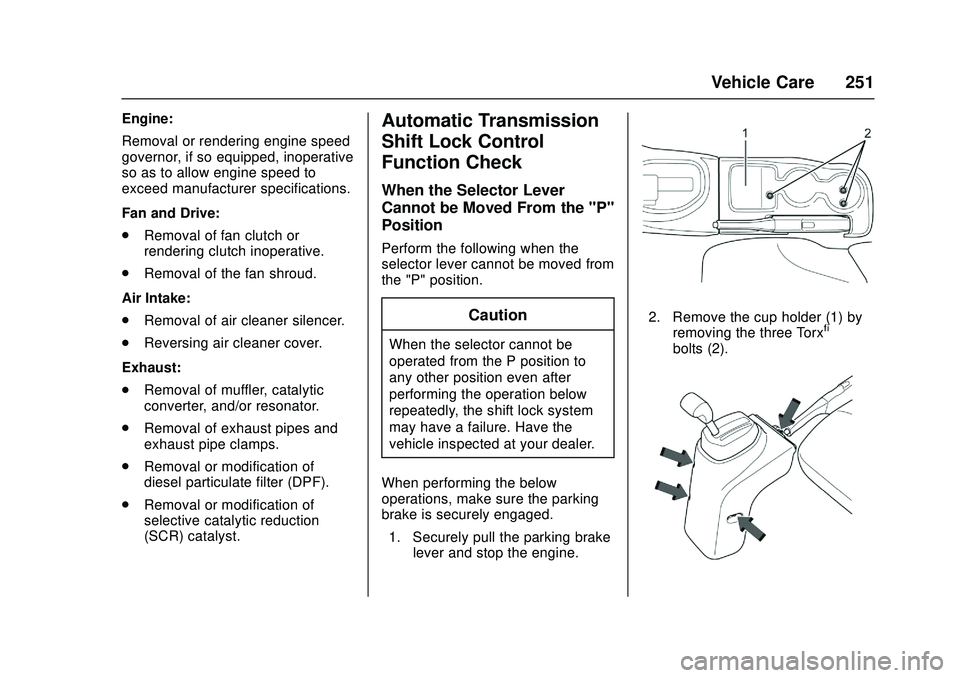
Chevrolet Low Cab Forward Owner Manual (GMNA-Localizing-U.S.-
11254764) - 2018 - crc - 12/5/16
Vehicle Care 251
Engine:
Removal or rendering engine speed
governor, if so equipped, inoperative
so as to allow engine speed to
exceed manufacturer specifications.
Fan and Drive:
.Removal of fan clutch or
rendering clutch inoperative.
. Removal of the fan shroud.
Air Intake:
. Removal of air cleaner silencer.
. Reversing air cleaner cover.
Exhaust:
. Removal of muffler, catalytic
converter, and/or resonator.
. Removal of exhaust pipes and
exhaust pipe clamps.
. Removal or modification of
diesel particulate filter (DPF).
. Removal or modification of
selective catalytic reduction
(SCR) catalyst.Automatic Transmission
Shift Lock Control
Function Check
When the Selector Lever
Cannot be Moved From the "P"
Position
Perform the following when the
selector lever cannot be moved from
the "P" position.
Caution
When the selector cannot be
operated from the P position to
any other position even after
performing the operation below
repeatedly, the shift lock system
may have a failure. Have the
vehicle inspected at your dealer.
When performing the below
operations, make sure the parking
brake is securely engaged. 1. Securely pull the parking brake lever and stop the engine.
2. Remove the cup holder (1) byremoving the three Torx®
bolts (2).
Page 255 of 358

Chevrolet Low Cab Forward Owner Manual (GMNA-Localizing-U.S.-
11254764) - 2018 - crc - 12/5/16
254 Vehicle Care
2. Continue pushing in the wiperrubber insert until the wiper
blade's hook engages with the
hole in it, and then confirm that
the rubber insert is securely
held in place.
3. Attach the wiper blade to the wiper arm.Headlamp Aiming
For vertical aiming, turn the two
screws indicated by arrows in the
diagram.
1. Remove the rubber beneath the headlight.
2. Two screws should be turned in the same direction at the
same time to adjust aiming.
3. When the headlamp aiming is out of position, contact your
dealer.
Bulb Replacement
Bulbs
1. Check each bulb for blowout.
2. If a bulb has blown out, replaceit. Always place the engine
control switch in the “LOCK”
position and place all the other
switches in the “OFF”position
before replacing the blown
bulbs.
3. If you need assistance replacing any bulbs, contact
your dealer.
Turn Signals
The flasher unit activates both the
turn signal circuits and the hazard
circuit. Should a lamp burn out, the
flasher unit will continue to operate.
Check the turn signal lamps visually
before the vehicle is used.
Page 282 of 358
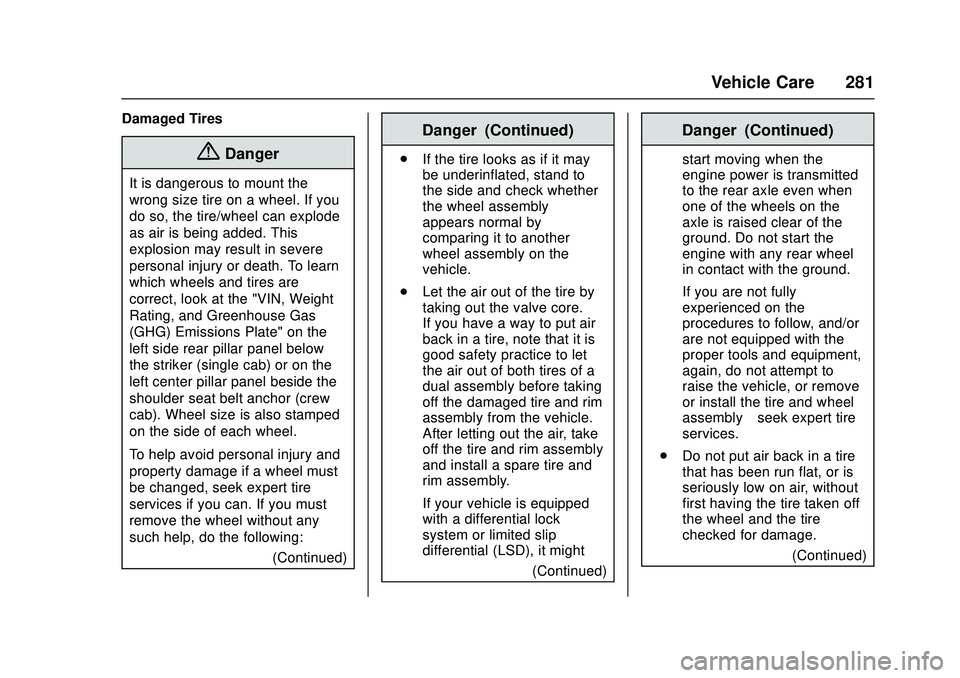
Chevrolet Low Cab Forward Owner Manual (GMNA-Localizing-U.S.-
11254764) - 2018 - crc - 12/5/16
Vehicle Care 281
Damaged Tires
{Danger
It is dangerous to mount the
wrong size tire on a wheel. If you
do so, the tire/wheel can explode
as air is being added. This
explosion may result in severe
personal injury or death. To learn
which wheels and tires are
correct, look at the "VIN, Weight
Rating, and Greenhouse Gas
(GHG) Emissions Plate" on the
left side rear pillar panel below
the striker (single cab) or on the
left center pillar panel beside the
shoulder seat belt anchor (crew
cab). Wheel size is also stamped
on the side of each wheel.
To help avoid personal injury and
property damage if a wheel must
be changed, seek expert tire
services if you can. If you must
remove the wheel without any
such help, do the following:(Continued)
Danger (Continued)
.If the tire looks as if it may
be underinflated, stand to
the side and check whether
the wheel assembly
appears normal by
comparing it to another
wheel assembly on the
vehicle.
. Let the air out of the tire by
taking out the valve core.
If you have a way to put air
back in a tire, note that it is
good safety practice to let
the air out of both tires of a
dual assembly before taking
off the damaged tire and rim
assembly from the vehicle.
After letting out the air, take
off the tire and rim assembly
and install a spare tire and
rim assembly.
If your vehicle is equipped
with a differential lock
system or limited slip
differential (LSD), it might
(Continued)
Danger (Continued)
start moving when the
engine power is transmitted
to the rear axle even when
one of the wheels on the
axle is raised clear of the
ground. Do not start the
engine with any rear wheel
in contact with the ground.
If you are not fully
experienced on the
procedures to follow, and/or
are not equipped with the
proper tools and equipment,
again, do not attempt to
raise the vehicle, or remove
or install the tire and wheel
assembly—seek expert tire
services.
. Do not put air back in a tire
that has been run flat, or is
seriously low on air, without
first having the tire taken off
the wheel and the tire
checked for damage.
(Continued)
Page 288 of 358
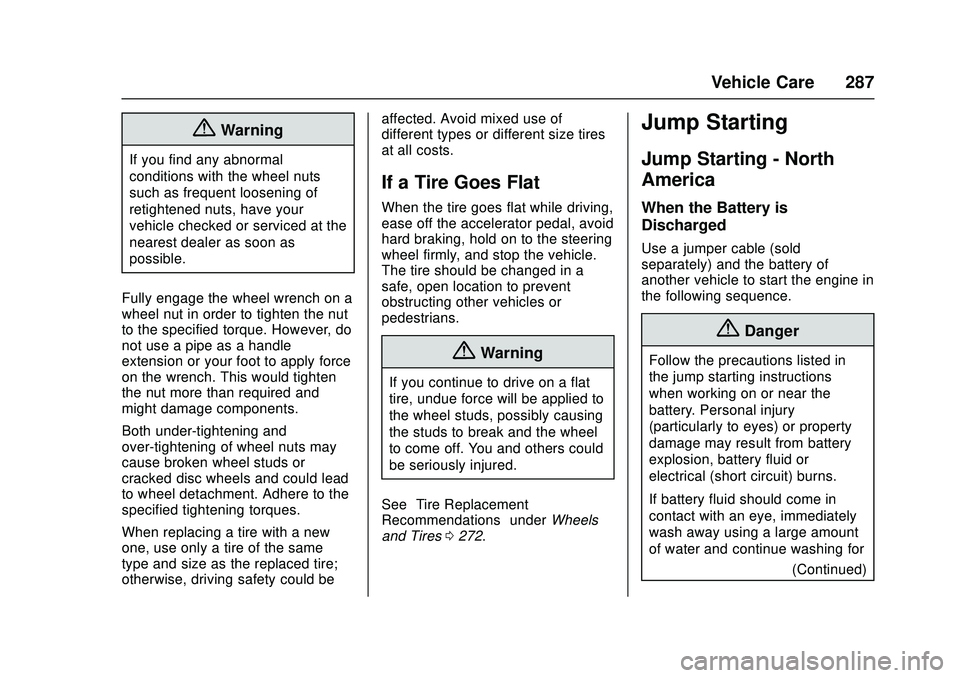
Chevrolet Low Cab Forward Owner Manual (GMNA-Localizing-U.S.-
11254764) - 2018 - crc - 12/5/16
Vehicle Care 287
{Warning
If you find any abnormal
conditions with the wheel nuts
such as frequent loosening of
retightened nuts, have your
vehicle checked or serviced at the
nearest dealer as soon as
possible.
Fully engage the wheel wrench on a
wheel nut in order to tighten the nut
to the specified torque. However, do
not use a pipe as a handle
extension or your foot to apply force
on the wrench. This would tighten
the nut more than required and
might damage components.
Both under-tightening and
over-tightening of wheel nuts may
cause broken wheel studs or
cracked disc wheels and could lead
to wheel detachment. Adhere to the
specified tightening torques.
When replacing a tire with a new
one, use only a tire of the same
type and size as the replaced tire;
otherwise, driving safety could be affected. Avoid mixed use of
different types or different size tires
at all costs.
If a Tire Goes Flat
When the tire goes flat while driving,
ease off the accelerator pedal, avoid
hard braking, hold on to the steering
wheel firmly, and stop the vehicle.
The tire should be changed in a
safe, open location to prevent
obstructing other vehicles or
pedestrians.
{Warning
If you continue to drive on a flat
tire, undue force will be applied to
the wheel studs, possibly causing
the studs to break and the wheel
to come off. You and others could
be seriously injured.
See “Tire Replacement
Recommendations” underWheels
and Tires 0272.
Jump Starting
Jump Starting - North
America
When the Battery is
Discharged
Use a jumper cable (sold
separately) and the battery of
another vehicle to start the engine in
the following sequence.
{Danger
Follow the precautions listed in
the jump starting instructions
when working on or near the
battery. Personal injury
(particularly to eyes) or property
damage may result from battery
explosion, battery fluid or
electrical (short circuit) burns.
If battery fluid should come in
contact with an eye, immediately
wash away using a large amount
of water and continue washing for
(Continued)
Page 306 of 358
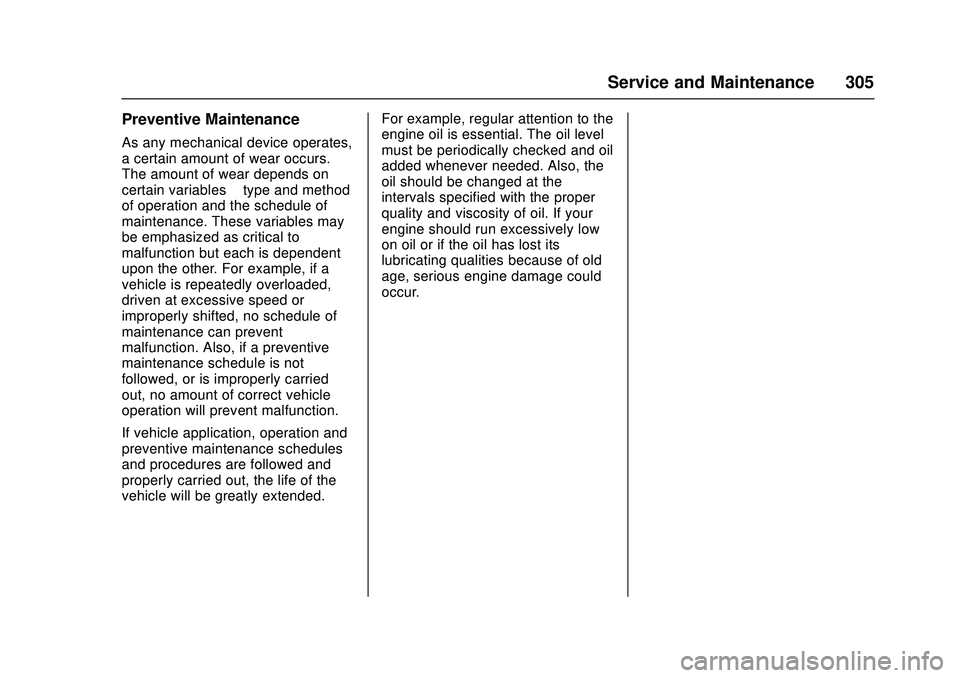
Chevrolet Low Cab Forward Owner Manual (GMNA-Localizing-U.S.-
11254764) - 2018 - crc - 12/5/16
Service and Maintenance 305
Preventive Maintenance
As any mechanical device operates,
a certain amount of wear occurs.
The amount of wear depends on
certain variables–type and method
of operation and the schedule of
maintenance. These variables may
be emphasized as critical to
malfunction but each is dependent
upon the other. For example, if a
vehicle is repeatedly overloaded,
driven at excessive speed or
improperly shifted, no schedule of
maintenance can prevent
malfunction. Also, if a preventive
maintenance schedule is not
followed, or is improperly carried
out, no amount of correct vehicle
operation will prevent malfunction.
If vehicle application, operation and
preventive maintenance schedules
and procedures are followed and
properly carried out, the life of the
vehicle will be greatly extended. For example, regular attention to the
engine oil is essential. The oil level
must be periodically checked and oil
added whenever needed. Also, the
oil should be changed at the
intervals specified with the proper
quality and viscosity of oil. If your
engine should run excessively low
on oil or if the oil has lost its
lubricating qualities because of old
age, serious engine damage could
occur.
Page 307 of 358
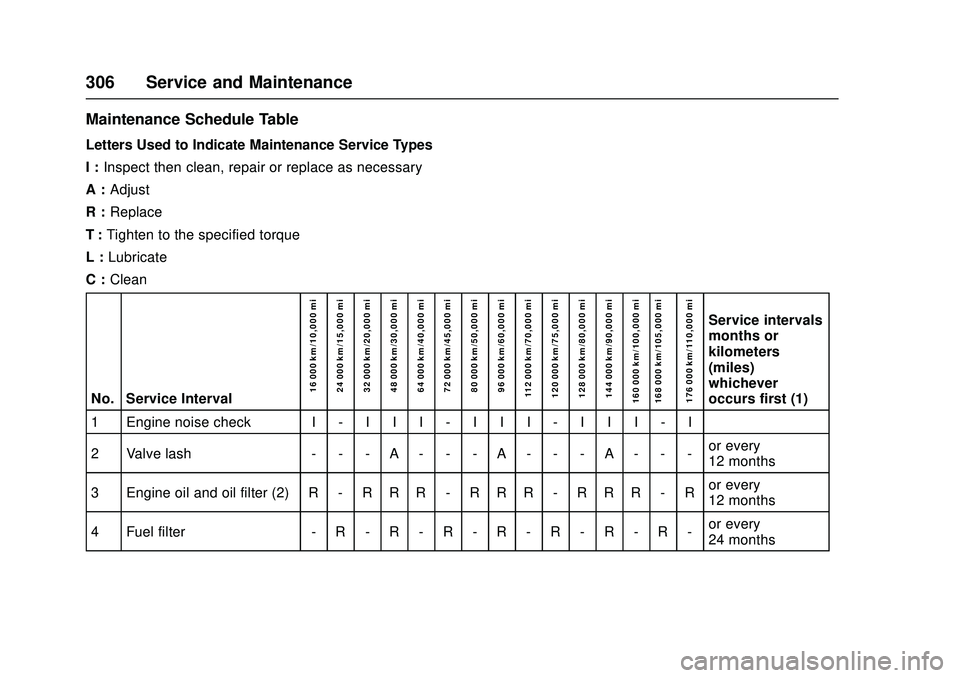
Chevrolet Low Cab Forward Owner Manual (GMNA-Localizing-U.S.-
11254764) - 2018 - crc - 12/5/16
306 Service and Maintenance
Maintenance Schedule Table
Letters Used to Indicate Maintenance Service Types
I :Inspect then clean, repair or replace as necessary
A : Adjust
R : Replace
T : Tighten to the specified torque
L : Lubricate
C : Clean
No. Service Interval
16 000 km/10,000 mi
24 000 km/15,000 mi
32 000 km/20,000 mi
48 000 km/30,000 mi
64 000 km/40,000 mi
72 000 km/45,000 mi
80 000 km/50,000 mi
96 000 km/60,000 mi
112 000 km/70,000 mi
120 000 km/75,000 mi
128 000 km/80,000 mi
144 000 km/90,000 mi
160 000 km/100,000 mi
168 000 km/105,000 mi
176 000 km/110,000 mi
Service intervals
months or
kilometers
(miles)
whichever
occurs first (1)
1 Engine noise check I - I I I - I I I - I I I - I
2 Valve lash - - - A - - - A - - - A - - - or every
12 months
3 Engine oil and oil filter (2) R - R R R - R R R - R R R - R or every
12 months
4 Fuel filter - R - R - R - R - R - R - R - or every
24 months
Page 313 of 358

Chevrolet Low Cab Forward Owner Manual (GMNA-Localizing-U.S.-
11254764) - 2018 - crc - 12/5/16
312 Service and Maintenance
Remarks
(1)In case this column is blank,
follow kilometers (miles).
(2) Use of oils other than CK-4 may
require shorter maintenance
intervals and may cause
nonconformity to regulations. (CJ-4
can be used while it is available.)
Use of oils with other viscosity than
*W-40 may also require shorter
maintenance intervals and may
cause a problem with engine
durability.
(3) Refer to "Air Cleaner Indicator
Light" under Engine Air Cleaner/
Filter 0231.
(4) Initial check at 1 040 km
(650 miles) is required.
(5) Be sure to discard used grease
seal, and always use new grease
seal for installation.
Explanation of Complete
Vehicle Maintenance Schedule
The following is a brief explanation
of each of the services listed in the
preceding Complete Vehicle
Maintenance Schedule. 1. Engine Noise :
These
components have an effect on the
control of noise emissions.
Service Interval Maintenance procedureEngine
Every 16 000 km (10,000 miles) Inspect sound absorption materials for
tears, broken out sections or
attachment. Repair or replace as
necessary.
Cooling System
Every 16 000 km (10,000 miles) Inspect fan, shroud and radiator for
attachment, tears or cleanliness.
Replace as necessary.
Air intake system
Every 24 000 km (1,500 miles) Inspect all ducts, hoses and intake
silencers for leaks or chafing. Repair or
replace as necessary.
Exhaust system
Every 16 000 km (10,000 miles) Inspect silencer, pipes, gaskets, clamps
and mounting for exhaust gas leaks or
looseness. Repair or replace as
necessary.
Cab
Every 16 000 km (10,000 miles) Inspect sound absorption materials for
tears, broken out sections or
attachment. Repair or replace as
necessary.
2. Valve Lash : Incorrect valve
clearance will result in increased
engine noise and lower engine output, thereby adversely affecting
engine performance. Retorque